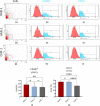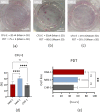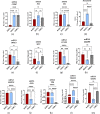Identification and characterization of stromal-like cells with CD207+/low CD1a+/low phenotype derived from histiocytic lesions - a perspective in vitro model for drug testing
- PMID: 38342891
- PMCID: PMC10860276
- DOI: 10.1186/s12885-023-11807-0
Identification and characterization of stromal-like cells with CD207+/low CD1a+/low phenotype derived from histiocytic lesions - a perspective in vitro model for drug testing
Abstract
Background: Histiocytoses are rare disorders manifested by increased proliferation of pathogenic myeloid cells sharing histological features with macrophages or dendritic cells and accumulating in various organs, i.a., bone and skin. Pre-clinical in vitro models that could be used to determine molecular pathways of the disease are limited, hence research on histiocytoses is challenging. The current study compares cytophysiological features of progenitor, stromal-like cells derived from histiocytic lesions (sl-pHCs) of three pediatric patients with different histiocytoses types and outcomes. The characterized cells may find potential applications in drug testing.
Methods: Molecular phenotype of the cells, i.e. expression of CD1a and CD207 (langerin), was determined using flow cytometry. Cytogenetic analysis included GTG-banded metaphases and microarray (aCGH) evaluation. Furthermore, the morphology and ultrastructure of cells were evaluated using a confocal and scanning electron microscope. The microphotographs from the confocal imaging were used to reconstruct the mitochondrial network and its morphology. Basic cytophysiological parameters, such as viability, mitochondrial activity, and proliferation, were analyzed using multiple cellular assays, including Annexin V/7-AAD staining, mitopotential analysis, BrdU test, clonogenicity analysis, and distribution of cells within the cell cycle. Biomarkers potentially associated with histiocytoses progression were determined using RT-qPCR at mRNA, miRNA and lncRNA levels. Intracellular accumulation of histiocytosis-specific proteins was detected with Western blot. Cytotoxicyty and IC50 of vemurafenib and trametinib were determined with MTS assay.
Results: Obtained cellular models, i.e. RAB-1, HAN-1, and CHR-1, are heterogenic in terms of molecular phenotype and morphology. The cells express CD1a/CD207 markers characteristic for dendritic cells, but also show intracellular accumulation of markers characteristic for cells of mesenchymal origin, i.e. vimentin (VIM) and osteopontin (OPN). In subsequent cultures, cells remain viable and metabolically active, and the mitochondrial network is well developed, with some distinctive morphotypes noted in each cell line. Cell-specific transcriptome profile was noted, providing information on potential new biomarkers (non-coding RNAs) with diagnostic and prognostic features. The cells showed different sensitivity to vemurafenib and trametinib.
Conclusion: Obtained and characterized cellular models of stromal-like cells derived from histiocytic lesions can be used for studies on histiocytosis biology and drug testing.
Keywords: Cell lines; Cellular model; Histiocytoses; In vitro study; Langerhans cell histiocytosis; Rare disorders.
© 2024. The Author(s).
Conflict of interest statement
The authors declare no competing interests.
Figures











Similar articles
-
Langerin (CD207) staining in normal pediatric tissues, reactive lymph nodes, and childhood histiocytic disorders.Pediatr Dev Pathol. 2004 Nov-Dec;7(6):607-14. doi: 10.1007/s10024-004-3027-z. Epub 2004 Nov 8. Pediatr Dev Pathol. 2004. PMID: 15630529
-
CD207+CD1a+ cells circulate in pediatric patients with active Langerhans cell histiocytosis.Blood. 2017 Oct 26;130(17):1898-1902. doi: 10.1182/blood-2017-05-782730. Epub 2017 Aug 28. Blood. 2017. PMID: 28847997
-
Monitoring Circulating CD207+CD1a+ Cells in Langerhans Cell Histiocytosis and Clinical Implications.J Immunol. 2022 Jul 15;209(2):270-279. doi: 10.4049/jimmunol.2200147. Epub 2022 Jun 29. J Immunol. 2022. PMID: 35768149
-
Cutaneous histiocytoses in children.Histopathology. 2022 Jan;80(1):196-215. doi: 10.1111/his.14569. Histopathology. 2022. PMID: 34958507 Review.
-
Successful treatment of Langerhans cell histiocytosis in an infant with vemurafenib: a case report and literature review.J Dermatolog Treat. 2023 Dec;34(1):2279901. doi: 10.1080/09546634.2023.2279901. Epub 2023 Nov 9. J Dermatolog Treat. 2023. PMID: 37941458 Review.
References
-
- Emile J-F, Abla O, Fraitag S, Horne A, Haroche J, Donadieu J, Requena-Caballero L, Jordan MB, Abdel-Wahab O, Allen CE, et al. Revised classification of histiocytoses and neoplasms of the macrophage-dendritic cell lineages. Blood. 2016;127:2672–2681. doi: 10.1182/blood-2016-01-690636. - DOI - PMC - PubMed
MeSH terms
Substances
Grants and funding
LinkOut - more resources
Full Text Sources
Research Materials
Miscellaneous

